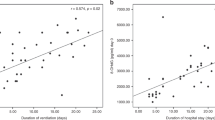Abstract
Objective
To determine the prooxidant-antioxidant balance (PAB) in neonatal asphyxia and compare it with values for PAB in healthy neonates.
Methods
In a prospective observational study, serum PAB of umbilical cord blood of 30 neonates with asphyxia [pH < 7.2, low Apgar score, signs of respiratory distress syndrome (RDS)] as the case group and 35 healthy neonates (without an abnormal clinical event at birth and after the first week) as the control group were compared.
Results
Among the 35 neonates in the control group, the average level of serum PAB was 20.00 HK units, which was significantly lower than for the 30 neonates within the case group (40.46 HK units; p = 0.019). The blood pH in the case group was significantly lower than for control group (P < 0.001). In controls, HCO3 - and pCO2 were 18.6 mmol/L and 38.5 mmHg respectively, whilst in the case group these values were 15.5 mmol/L and 45.7 mmHg respectively (p < 0.05).
Conclusions
Determination of PAB may be useful in the early diagnosis of perinatal asphyxia and is consistent with HCO3 -, pCO2 and Apgar score.

Similar content being viewed by others
References
Low JA. The role of blood gas and acid–base assessment in the diagnosis of intrapartum fetal asphyxia. Am J Obstet Gynecol. 1988;159:1235–40.
Jones G, Steketee RW, Black RE, Bhutta ZA, Morris SS. How many child deaths can we prevent this year? Lancet. 2003;362:65–71.
Oswyn G, Vince JD, Friesen H. Perinatal asphyxia at Port Moresby General Hospital: A study of incidence, risk factors and outcome. P N G Med J. 2000;43:110–20.
Levene ML, Kornberg J, Williams TH. The incidence and severity of post-asphyxial encephalopathy in full-term infants. Early Hum Dev. 1985;11:21–6.
Thornberg E, Thiringer K, Odeback A, Milsom I. Birth asphyxia: Incidence, clinical course and outcome in a Swedish population. Acta Paediatr. 1995;84:927–32.
Azzopardi DV, Strohm B, Edwards AD, Dyet L, Halliday HL, Juszczak E, et al; TOBY Study Group. Moderate hypothermia to treat perinatal asphyxial encephalopathy. N Engl J Med. 2009;361:1349–58.
Reddy S, Dutta S, Narang A. Evaluation of lactate dehydrogenase, creatine kinase and hepatic enzymes for the retrospective diagnosis of perinatal asphyxia among sick neonates. Indian Pediatr. 2008;45:144–7.
Boskabadi H, Maamouri G, Sadeghian MH, Ghayour-Mobarhan M, Heidarzade M, Shakeri MT, et al. Early diagnosis of perinatal asphyxia by nucleated red blood cell count: A case–control study. Arch Iran Med. 2010;13:275–81.
Ghosh B, Mittal S, Kumar S, Dadhwal V. Prediction of perinatal asphyxia with nucleated red blood cells in cord blood of newborns. Int J Gynaecol Obstet. 2003;81:267–71.
Hill A, Volpe JJ. Perinatal asphyxia: Clinical aspects. Clin Perinatol. 1989;16:435–57.
Hankins GD, Speer M. Defining the pathogenesis and pathophysiology of neonatal encephalopathy and cerebral palsy. Obstet Gynecol. 2003;102:628–36.
Kumar A, Ramakrishna SV, Basu S, Rao GR. Oxidative stress in perinatal asphyxia. Pediatr Neurol. 2008;38:181–5.
Scher M. Perinatal asphyxia: Timing and mechanisms of injury in neonatal encephalopathy. Curr Neurol Neurosci Rep. 2001;1:175–84.
Cheeseman KH, Slater TF. An introduction to free radical biochemistry. Br Med Bull. 1993;49:481–93.
Southorn PA, Powis G. Free radicals in medicine. I. Chemical nature and biologic reactions. Mayo Clin Proc. 1988;63:381–9.
Alamdari DH, Paletas K, Pegiou T, Sarigianni M, Befani C, Koliakos G. A novel assay for the evaluation of the prooxidant-antioxidant balance, before and after antioxidant vitamin administration in type II diabetes patients. Clin Biochem. 2007;40:248–54.
Martín-Ancel A, García-Alix A, Gayá F, Cabañas F, Burgueros M, Quero J. Multiple organ involvement in perinatal asphyxia. J Pediatr. 1995;127:786–93.
Garzoli E, Monteleone M, Migliori C, Abrami F. Umbilical acid–base status of term infants: Correlation with delivery mode. Pediatr Med Chir. 2007;29:202–5.
Chen ZL. Multicenter clinical study on umbilical cord arterial blood gas parameters for diagnosis of neonatal asphyxia. Zhonghua Er Ke Za Zhi. 2010;48:668–73.
Gao C, Yuan L, Wang J. Role of pH value of umbilical artery blood in neonatal asphyxia. Zhongguo Dang Dai Er Ke Za Zhi. 2009;11:521–4.
McGuire W. Perinatal asphyxia. Clin Evid (Online). 2007;2007. pii: 0320.
Shoji H, Shimizu T. Antioxidative properties of human milk and spermine are not related to expression of Hsp 70. Acta Paediatr. 2008;97:81–4.
Aydemir O, Akar M, Uras N, Eras Z, Erdeve O, Oguz SS, et al. Total antioxidant capacity and total oxidant status in perinatal asphyxia in relation to neurological outcome. Neuropediatrics. 2011;42:222–6. doi:10.1055/s-0031-1295480.
Alamdari DH, Ghayour-Mobarhan M, Tavallaie S, Parizadeh MR, Moohebati M, Ghafoori F, et al. Prooxidant-antioxidant balance as a new risk factor in patients with angiographically defined coronary artery disease. Clin Biochem. 2008;41:375–80.
Ghayour-Mobarhan M, Alamdari DH, Moohebati M, Sahebkar A, Nematy M, Safarian M, et al. Determination of prooxidant—antioxidant balance after acute coronary syndrome using a rapid assay: A pilot study. Angiology. 2009 Dec–2010 Jan;60:657–62.
Koliakos GG, Befani CD, Mikropoulos D, Ziakas NG, Konstas AG. Prooxidant-antioxidant balance, peroxide and catalase activity in the aqueous humour and serum of patients with exfoliation syndrome or exfoliative glaucoma. Graefes Arch Clin Exp Ophthalmol. 2008;246:1477–83.
Parizadeh SM, Azarpazhooh MR, Moohebati M, Nematy M, Ghayour-Mobarhan M, Tavallaie S, et al. Simvastatin therapy reduces prooxidant-antioxidant balance: Results of a placebo-controlled cross-over trial. Lipids. 2011;46:333–40.
Boskabadi H, Moeini M, Tara F, Tavallaie S, Saber H, Nejati R, et al. Determination of prooxidant–antioxidant balance during uncomplicated pregnancy using a rapid assay. J Med Biochem. 2013;32:227–32.
Tara F, Rayman MP, Boskabadi H, Ghayour-Mobarhan M, Sahebkar A, Alamdari DH, et al. Prooxidant-antioxidant balance in pregnancy: a randomized double-blind placebo-controlled trial of selenium supplementation. J Perinat Med. 2010;38:473–8.
Parizadeh MR, Azarpazhooh MR, Mobarra N, Nematy M, Alamdari DH, Tavalaie S, et al. Prooxidant-antioxidant balance in stroke patients and 6-month prognosis. Clin Lab. 2011;57:183–91.
Conflict of Interest
None.
Role of Funding Source
None.
Author information
Authors and Affiliations
Corresponding author
Rights and permissions
About this article
Cite this article
Boskabadi, H., Navaee Boroujeni, A., Mostafavi-Toroghi, H. et al. Prooxidant-Antioxidant Balance in Perinatal Asphyxia. Indian J Pediatr 81, 248–253 (2014). https://doi.org/10.1007/s12098-013-1239-9
Received:
Accepted:
Published:
Issue Date:
DOI: https://doi.org/10.1007/s12098-013-1239-9




